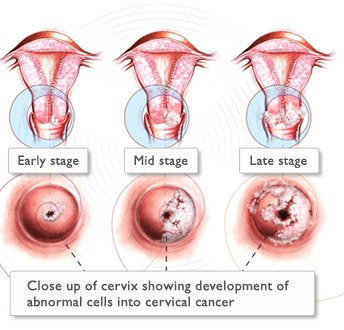A Swedish study suggests that women diagnosed with cervical cancer as a result of a smear test have a far better chance of being cured than women who do not go for tests.
The study shows a 92% cure rate after a smear test diagnosis, compared with 66% for symptoms-based diagnoses.
Published in bmj.com, the study looked at all women diagnosed with cervical cancer in Sweden between 1999 and 2001.
The research, carried out at the Karolinska Institute in Stockholm, followed 1,230 women for an average of eight years after diagnosis.
To estimate the chances of surviving cervical cancer, the study analyzed cancers detected by an abnormal smear test result and all other cases based on diagnosis using symptoms.

The Swedish study shows a 92 percent cure rate of cervical cancer after a smear test diagnosis, compared with 66 percent for symptoms-based diagnoses
The percentage of women cured after presenting with symptoms within the recommended interval between screenings was 74%.
But for women with symptoms who were overdue for screening, this cure rate decreased to 60%.
Researchers found that the chances of being cured for all women who had a smear test within the recommended three to five years were 11% higher than for women who were overdue or who had never had a smear test.
This is a result of screen-detected cancers generally being found at an earlier stage, the study says.
Three-quarters of the 373 women who died from cervical cancer in the Swedish study had not had a cervical smear in the recommended timeframe.
Dr. Bengt Andrae, study author and senior consultant gynaecologist at Uppsala University, said that screening both reduced the risk of cervical cancer and was linked with improved likelihood of cure.
“Even if you have not gone to cervical screening before, go when you are invited because you have a much better prognosis than waiting for the symptoms to appear.”
The Swedish cervical screening programme invites women aged 23-50 to attend every three years and women aged 51-60 to attend every five years.
Donna Kelly from UK, who suffered two miscarriages in the past, spent ten weeks, 24 hours a day, laid “upside down” in a hospital bed until she gave birth to a healthy daughter.
When doctors told five months pregnant Donna Kelly, 29, that she was at high risk of losing another baby, she readily agreed to their radical solution.
Ultrasound scans had shown that damage to the neck of Donna Kelly womb, or cervix, meant the baby had dropped too far down.
To alter the force of gravity on her cervix, Donna Kelly lay in a bed tilted at a 45 degree angle with her feet pointing upwards.
Donna Kelly had to eat, read and watch television in the bed at University Hospital in Coventry, only getting out of it to go to the toilet.
Donna Kelly, who gave up work as a gynaecology nurse following the birth of her son Joshua four years ago, said: “I was surprised when she told me to lie in bed at a tilt but I was ready to give anything a try.
“It made me feel sick at first but after a couple of days my body adjusted and I soon got used to it.
“I propped myself up with pillows and the barrier round the bed kept me from falling out.
“I’d even have to stay in the bed to eat by rolling on to my side, but I’d always have a dead arm by the end. It could be boring at times but I knew it wouldn’t be as painful as losing my baby.”
Doctors told Donna Kelly and husband Mark, 32, a Sky television installation engineer, that Joshua’s natural birth may have permanently weakened her cervix. They think this caused her to miscarry in January 2009 at 23 weeks and again in May 2010 at 19 weeks.
This time Donna Kelly was given cream containing the hormone progesterone to help strengthen the cervix and prevent infection.
She also underwent a cervical stitch at 14 weeks to strengthen the neck of the womb but by 23 weeks the cervix had re-opened.
Professor Siobhan Quenby, an expert in recurrent miscarriages, told the couple the only chance of preventing another miscarriage was to reduce the pressure on her cervix by making her lie at a tilt.
While his mother was in hospital, Joshua went to nursery but visited her each evening with his father. Donna Kelly gave birth to 4lb 15oz Amelia by emergency caesarean in August after her waters broke six weeks early.
Baby Amelia spent two weeks in an incubator in intensive care before the couple was allowed to take her to their Coventry home, where she is now thriving.
Donna Kelly added: “The other day Joshua said to me, <<Mummy, I love being a big brother>. For me that makes it all worthwhile.”
Prof. Siobhan Quenby said there were several causes of cervical weakness, including damage from previous births and miscarriages, smear tests and treatment for pre-cancerous cells.
“Donna’s cervical weakness was bad as you can get,” she added.
“It’s the weakest I’ve ever dealt with.
“The concept of keeping a woman at a tilt is relatively simple – it’s basic physics – and while it may sound strange, it is very effective.”
Prof. Sionhan Quenby said it costs around £300 ($450) per day to keep a patient in hospital, but the cost of caring for a premature baby in hospital is around £2,000 ($3,000) per day.

